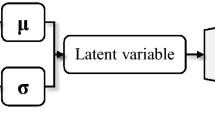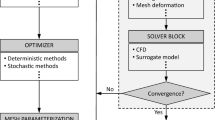Abstract
An objective of mechanical design is to obtain a shape that satisfies specific requirements. In the present work, we achieve this goal using a conditional variational autoencoder (CVAE). The method enables us to analyze the relationship between aerodynamic performance and the shape of aerodynamic parts, and to explore new designs for the parts. In the CVAE model, a shape is fed as an input and the corresponding aerodynamic performance index is fed as a continuous label. Then, shapes are generated by specifying the continuous label and latent vector. When CVAE is applied to mechanical design, it is desired to draw shapes that reproduce the specified aerodynamic performance. In ordinal CVAE, the model is trained to minimize reconstruction loss and latent loss, and it is usually optimized considering the sum of these losses. However, the present study shows that the optimal network is not always optimal in terms of reproducing the aerodynamic performance. The proposed method is verified using two numerical examples: a two-dimensional (2D) airfoil and a turbine blade. In the airfoil example, we demonstrate the effects of latent dimension, and in the turbine design example, we demonstrate that the proposed method can be applied to a real turbine design problem and reduce the design time.


















Similar content being viewed by others
References
Abadi M, Agarwal A, Barham P, Brevdo E, Chen Z, Citro C, Corrado GS, Davis A, Dean J, Devin M, Ghemawat S, Goodfellow I, Harp A, Irving G, Isard M, Jia Y, Jozefowicz R, Kaiser L, Kudlur M, Levenberg J, Mané D, Monga R, Moore S, Murray D, Olah C, Schuster M, Shlens J, Steiner B, Sutskever I, Talwar K, Tucker P, Vanhoucke V, Vasudevan V, Viégas F, Vinyals O, Warden P, Wattenberg M, Wicke M, Yu Y, Zheng X (2015) TensorFlow: large-scale machine learning on heterogeneous systems. Software available from tensorflow.org
Abbot IH, von Doenhoff AE, Stivers L Jr (1945) Summary of airfoil data. NACA-TR-824
Akiba T, Sano S, Yanase T, Ohta T, Koyama M (2019) Optuna: a next-generation hyperparameter optimization framework. In: Proceedings of the 25th ACM SIGKDD international conference on knowledge discovery and data mining, pp 2623–2631
Bendsøe MP, Sigmund O (2003) Topology optimization: theory, methods and applications, 2nd edn. Springer, Berlin
Bonaiuti D, Zangeneh M, Aartojarvi R, Eriksson J (2010) Parametric design of a waterjet pump by means of inverse design, CFD calculations and experimental analyses. J Fluids Eng 132(3):031104
Brown NC, Mueller CT (2019) Design variable analysis and generation for performance-based parametric modeling in architecture. Int J Archit Comput 17(1):36–52
Cao S, Peng G, Yu Z (2005) Hydrodynamic design of rotodynamic pump impeller for multiphase pumping by combined approach of inverse design and CFD analysis. J Fluids Eng 172(2):330–338
Davidson TR, Falorsi L, de Cao N, Kipf T, Tomczak JM (2018) Hyperspherical variational auto-encoders. In: 34th conference on uncertainty in artificial Intelligence (UAI-18)
Dorney DJ, Lake JP, King P, Ashpis D (2000) Experimental and numerical investigation of losses in low-pressure turbine blade rows. Int J Turbo Jet Eng 17(4):241–253
Drela M (1989) Xfoil: An analysis and design system for low Reynolds number airfoils. In: Mueller TJ (ed) Low Reynolds number aerodynamics, lecture notes in engineering, vol 54. Springer, Berlin, pp 1–12
Gaggero S, Vernengo G, Villa D, Bonfiglio L (2020) A reduced order approach for optimal design of efficient marine propellers. Ships Offshore Struc 15(2):319–328
Goto A, Zangeneh M (2002) Hydrodynamic design of pump diffuser using inverse design method and CFD. J Fluids Eng 124(2):319– 328
Hinton GE, Salakhutdinov RR (2006) Reducing the dimensionality of data with neural networks. Science 313(5786):504–507
Imaizumi M, Fukumizu K (2019) Deep neural networks learn non-smooth functions effectively. J Mach Learn Res 89:869–878
Kennon SR, Dulikravich GS (1985) Inverse design of coolant flow passage shapes with partially fixed internal geometries. Int J Turbo Jet-Engines 3:13–20
Kingma DP, Welling M (2013) Auto-encoding variational bayes. In: The International Conference on Learning Representation (ICLR)
Lee I, Choi KK, Gorsick D (2010) System reliability-based design optimization using the MPP-based dimension reduction method. Struct Multidiscipl Optim 41(6):823–839
Li X, Ning S, Liu Z, Yan Z, Luo C, Zhuang Z (2020) Designing phononic crystal with anticipated band gap through a deep learning based data-driven method. Comput Methods Appl Mech Eng 361:112737
Liu MY, Breuel T, Kautz J (2017) Unsupervised image-to-image translation networks. In: Advances in neural information processing systems 30. pp 700–708
Narducci R, Grossman B, Haftka RT (1995) Sensitivity algorithms for an inverse design problem involving a shock wave. Inverse Probl Eng 2(1):49–83
Nita K, Okita Y, Nakamata C, Kubo S, Yonekura K, Watanabe O (2014) Film cooling hole shape optimization using proper orthogonal decomposition. In: ASME Turbo expo 2014: turbine technical conference and exposition, pp GT2014–27239
Nita K, Okita Y, Nakamata C, Kubo S, Yonekura K, Watanabe O (2017) Turbine blade. US Patent 9,759,069
van den Oord A, Vinyals O, Kavukcuoglu K (2017) Neural discrete representation learning. In: Advances in neural information processing systems, vol. 30, pp 6306–6315
Pedregosa F, Varoquaux G, Gramfort A, Michel V, Thirion B, Grisel O, Blondel M, Prettenhofer P, Weiss R, Dubourg V, Vanderplas J, Passos A, Cournapeau D, Brucher M, Perrot M, Duchesnay E (2011) Scikit-learn: machine learning in Python. J Mach Learn Res 12:2825–2830
Petrucci DR, Filho NM (2007) A fast algorithm for inverse airfoil design using a transpiration model and an improved vortex panel method. J Braz Soc Mech Sci Eng 29(4):354–365
Pu Y, Gan Z, Henao R, Yuan X, Li C, Stevens A, Carin L (2016) Variational autoencoder for deep learning of images, labels and captions. In: Advances in neural information processing systems 29, pp 2352–2360
Raifai S, Vincent P, Muller X, Glorot X, Bengio Y (2011) Contractive auto-encoders: explicit invariance during feature extraction. In: Proceedings of the 28th international conference on machine learning (ICML)
Selig MS, Maughmer MD (1992) Generalized multipont inverse airfoil design. AIAA J 30 (11):2618–2625
Sohn K, Lee H, Yan X (2015) Learning structured output representation using deep conditional generative models. In: Advances in neural information processing systems 28, pp 3483–3491
Sokolowski J, Zolesio JP (1992) Introduction to shape optimization. Springer, Berlin
Sun L, Gao H, Pan S, Wang JX (2020) Surrogate modeling for fluid flows based on physics-constrained deep learning without simulation data. Comput Methods Appl Mech Eng 361:112732
Bui-Thanh T, Damodaran M, Willcox K (2004) Aerodynamic data reconstruction and inverse design using proper orthogonal decomposition. AIAA J 42(8):1505–1516
Tan RK, Zhang NL, Ye W (2020) A deep learning-based method for the design of microstructural materials. Struct Multidiscip Optim 61(4):1417–1438
Tolstikhin I, Bousquet O, Gelly S (2018) Wasserstein auto-encoders. In: The International Conference on Learning Representations (ICLR)
Tortorelli DA, Michaleris P (1994) Design sensitivity analysis: overview and review. Inverse Probl Eng 1(1):71–105
Wang C, Yan Xu L, Sheng Fan J (2020) A general deep learning framework for history-dependent response prediction based on ua-seq2seq model. Comput Methods Appl Mech Eng 372:113357
Xu H, Chen W, Zhao N, Li Z, Bu J, Li Z, Liu Y, Zhao Y, Pei D, Feng Y, Chen J, Wang Z, Qiao H (2018) Unsupervised anomaly detection via variational auto-encoder for seasonal KPIs in web applications. In: Proceedings of the 2018 world wide web conference, pp 187–196
Yonekura K, Hattori H (2019) Framework for design optimization using deep reinforcement learning. Struct Multidiscip Optim 60(4):1709–1713
Yonekura K, Kanno Y (2015) A flow topology optimization method for steady state flow using transient information of flow field solved by lattice Boltzmann method. Struct Multidiscip Optim 51(1):159– 172
Yonekura K, Kanno Y (2016) Erratum to: A flow topology optimization method for steady state flow using transient information of flow field solved by lattice Boltzmann method. Struct Multidiscip Optim 54 (1):193–195
Yonekura K, Watanabe O (2014) A shape parameterization method using principal component analysis in application to shape optimization. J Mech Des 136(12):121401
Yu Y, Hur T, Jung J, Jang IG (2019) Deep learning for determining a near-optimal topological design without any iteration. Struct Multidiscip Optim 59(3):787–799
Zhang Y, Ye W (2019) Deep learning-based inverse method for layout design. Struct Multidiscip Optim 60(2):527–536
Zhengming W (1985) Inverse design calculations for transonic cascades. In Turbo Expo: Power for Land, Sea, and Air, pp 85-GT-6
Author information
Authors and Affiliations
Corresponding author
Ethics declarations
Conflict of interest
The authors declare that they have no conflict of interest.
Additional information
Responsible Editor: Ming Zhou
Replication of result
The source code of the neural networks used in the numerical experiments section is implemented using TensorFlow on Python. Even the NACA airfoil data are generated using Python. The turbine data are generated by an in-house code of IHI Corporation. We are willing to provide the data and source code upon a reasonable and responsible request. However, the copyrights of the in-house code for turbine data generation are reserved with IHI corporation and cannot be disclosed without permission from IHI Corporation.
Publisher’s note
Springer Nature remains neutral with regard to jurisdictional claims in published maps and institutional affiliations.
Rights and permissions
About this article
Cite this article
Yonekura, K., Suzuki, K. Data-driven design exploration method using conditional variational autoencoder for airfoil design. Struct Multidisc Optim 64, 613–624 (2021). https://doi.org/10.1007/s00158-021-02851-0
Received:
Revised:
Accepted:
Published:
Issue Date:
DOI: https://doi.org/10.1007/s00158-021-02851-0




